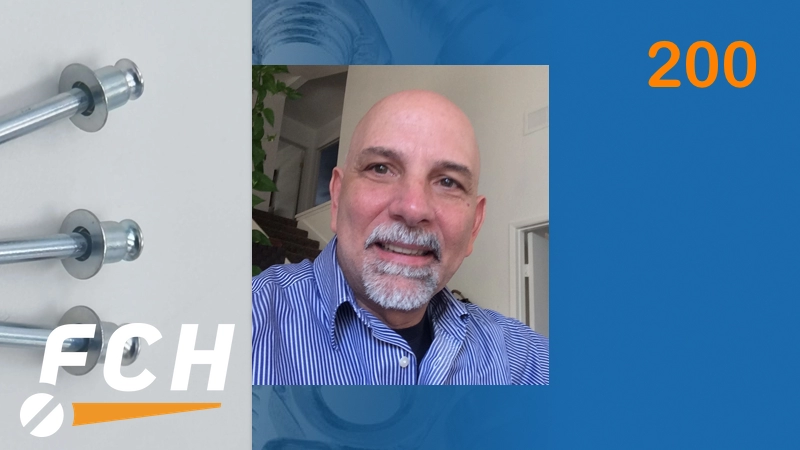This edition of the Fastener Training Minute with Carmen Vertullo was originally published May 22nd, 2024 as “What are the included angles associated with rivets and other fasteners?” during episode 200 of Fully Threaded Radio.
Well hello everyone, this is Carmen Vertullo with your Fastener Training Minute, coming to you from Fastener Training Institute and Carver Labs in beautiful El Cajon California.
Just a point of order that we must recognize. I’m sure you’ve heard this already on the show somewhere but congratulations to Fully Threaded Radio for their 200th episode. I’ve been around for a little over a hundred of them and I’m so proud of Eric and the team at Fully Threaded, Brian and all the people that contribute, and I’m really happy excited and proud to be part of that team. So, way to go Fully Threaded Radio.
Well today’s topic does not come from an email it comes from something that actually happened right out in our lab, and it has to do with testing blind rivets. We were testing some blind rivets and they were what we call countersunk rivets. That’s the terminology that we use when the rivet has a flat head and we discovered something about the angle on those countersunk rivets heads, and as a result we did some training in the shop. I found out some of my guys know some stuff about angles when it comes to fasteners, not just rivets, and it occurred to me that at one time during one of our Fastener Training Institute classes for the Certified Fastener Specialist, I taught a class on faster math and I had a couple of slides dedicated to various angles that we run into in the Fastener industry. So I thought we would talk about angles so what’s your angle? what matters to you? When we come back I’ll tell you what we discovered about these flat head blind rivet angles and some other things.
Well welcome back to the Fastener Training Minute, this is Carmen Vertullo and today we are talking about angles when it comes to fasteners. So we’re testing these blind rivets and it turned out this was a kind of an odd blind rivet for us. It’s one that we had not seen before. It’s called a pull through blind rivet, and it’s from IFI 117 and it looks just like a standard blind rivet, except the mandrel does not break it pulls all the way through, basically leaving a hollow core in the rivet after it’s set. and the IFI 114 standard which covers the common blind rivets, (all the ones that you buy normally without saying anything special come from IFI 114). Now those blind rivets from IFI 114 have a 120 degree angle under the Flathead, that’s called the included angle. So we go into testing these pull through rivets and we have to make a special test fixture for them. We do a shear test and a test that I guess we would call a tensile test, a pull-apart test. So we have to countersink the plate. Well it turns out that the pull-through rivets from IFI 117 have a 100-degree countersink not a 120 degree countersink. And because of that, I thought, well what do the other rivets have? Well we’re going to go down the list and I’m going to tell you because they are not all the same.
The IFI 114 blind rivet has a 100° flathead so you need 100 degree countersink.
The IFI 116 multi-grip rivet has a 120° flathead so you need 120 degree countersink.
The IFI 117 pull-through rivet has a 100° flathead so you need 100 degree countersink.
The IFI 119 structural rivet, which is kind of like the mono bolt, has a 100 degree countersunk head.
The IFI 126 closed and rivet has 120 degree head.
The IFI 130 structural splitting rivet has a 100 degree head
The IFI 123 drive pin rivet has a 100 degree head.
Most Aerospace Fasteners have a 120 degree head. Aerospace Flathead rivet Fasteners have a 120 degree head
And I thought, what about solid rivets? And there are a couple of solid rivets standards in the IFI book ,so I looked at two of them. One is ASME b18.1.1 for small solid rivets, and those are smaller than a half inch, they have a 100 degree head. but what about the larger ones which come from ASME b18.1.2. Those have a 78 degree head.
So this is kind of fastener trivia more than training, but it was very interesting to me. So I started wondering about what else we don’t know about angles. So I was asking out in the shop, because we have to have all these countersinks in order to make the tooling to test these rivets. And so I asked my guys what is the standard countersink for an inch fastener and they all knew 82° degrees is the standard. By the way, when you inspect these flatheads dimensionally, you’d look at the half angle, so we’re more concerned that half of the angle is 41 degrees than we are with the included angle being 82 degrees because the head could be crooked. So that’s why we check that and they knew about the 100 degree countersink that we can get with an inch fastener as well. So those are two choices 82 degrees and 100 degrees. A 100 degree gives us a shorter head so we can use it in thinner materials. But then I asked what about metric they didn’t know, but I knew. Anyway most people that sell metric fasteners know that the flathead metric fasteners have a 90 degree angle. So for our basic threaded fasteners we have 82 degrees and 100 degrees in the inche world and 90 degrees for metric screws. And then I started thinking about some other angles, like threads, for example. All of our threads in the inch world have a 60 degree included angle. This includes our space threads on our sheet metal screws and our standard machine screw threads that are on our screws and bolts. It turns out there are some other screws out there, large Timber Screws for example that may have a 45 degree included angle on them, and there are a couple of other weird angles out there that I’m not going to go into, such as the notch angle on a Sharpie impact specimen, or the notch angle off on a hydrogen embrittlement test bar. Anyway what’s your angle? You know a bunch of our angles now, and I thought it was very interesting to just chat about a few of the angles that we run into when we are testing and inspecting fasteners.
Well that’s your Fastener Training Minute, this was Carmen Vertullo, thanks for listening.





